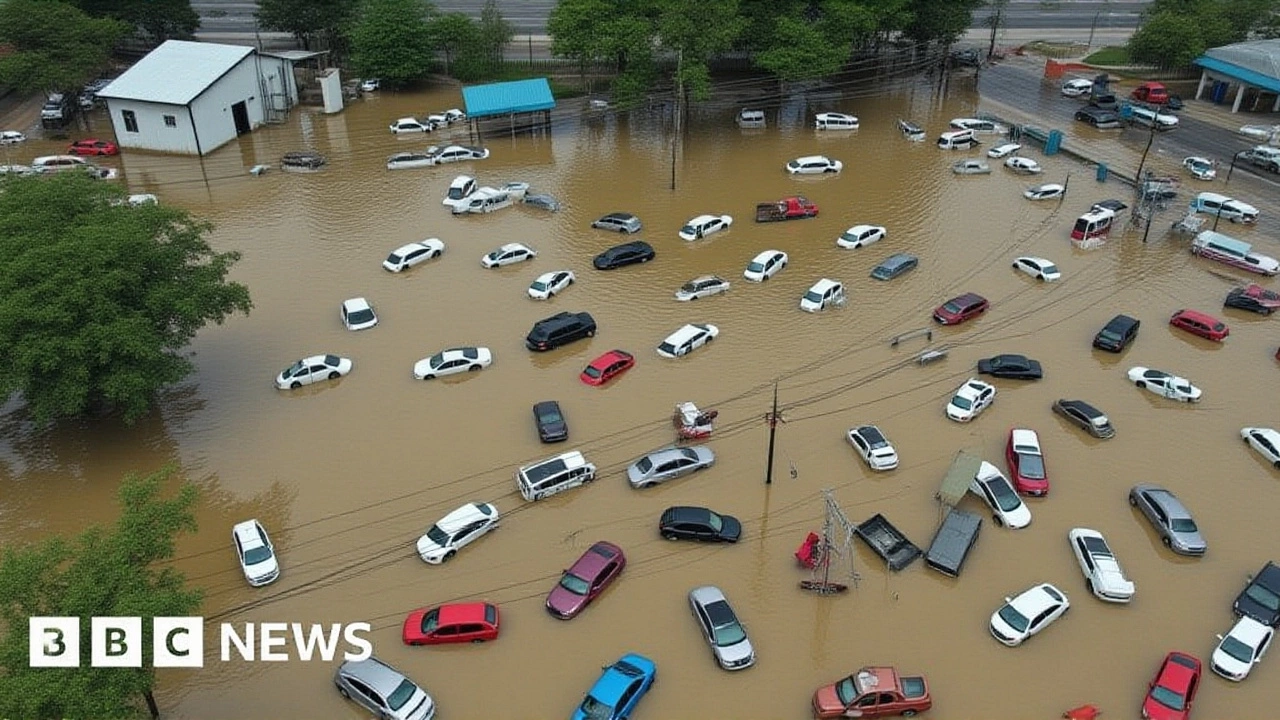At least 436 people have died across Thailand, Vietnam, Malaysia, Indonesia, and the Philippines as record-breaking rainfall triggered catastrophic floods and landslides — the worst in decades, and in some places, in 300 years. By Wednesday, November 26, 2025, entire cities were underwater, power grids collapsed, and rescue teams scrambled to reach isolated communities. The death toll is still rising. In Hat Yai, Thailand, a single day of rain — 13 inches on November 21 — shattered all records. People were trapped in hotels. Hospitals lost electricity. Roads vanished beneath mud and debris. This wasn’t just bad weather. It was a climate emergency unfolding faster than any government could prepare for.
When the Rain Stopped, the Real Crisis Began
Thailand’s southern provinces, especially Songkhla, were hit hardest. Over 2.1 million people were affected, with 33 confirmed dead — many killed by landslides or electrocution after floodwaters breached power lines. The city of Hat Yai, a major tourist hub for Malaysians, became an island. No electricity. No phones. No clean water. One woman rescued from a hotel told Channel News Asia: "We were really very, very trapped. The water was really rising. We were desperate for food. There was no electricity." In Vietnam, at least 90 people died in central provinces, with dozens still missing after rivers burst their banks. Indonesia recorded 38 deaths from landslides on November 24 alone. Malaysia evacuated over 25,000 people into 60 shelters, with 400 stranded by a single landslide in Perlis. The Philippines suffered the deadliest blow: over 200 fatalities from back-to-back typhoons that slammed the archipelago in mid-November.
Relief Efforts Struggle Against the Tide
Thailand deployed a naval carrier, 14 boats, and helicopters to deliver food, medicine, and fuel to cut-off towns. Rescue teams airlifted patients from flooded hospitals. But progress was slow. Roads were buried under meters of mud. Helicopters couldn’t land where trees had toppled across landing zones. In Malaysia, authorities monitored more than 3,000 flood hotspots across eight states. The Disaster Philanthropy Organization reported that over 1.9 million people in Thailand alone were displaced — many living in schools and community centers turned into emergency shelters.
What made it worse? The timing. Rain didn’t fall in waves — it poured in one relentless, unbroken surge. "This wasn’t a storm," said Seree Supratid, director of the Center for Climate Change and Disasters at Rangsit University. "It was a wall of water. The flooding in Hat Yai was an example of a crisis unfolding faster than Thailand’s adaptation measures could cope with." And it wasn’t just infrastructure that failed. Early warning systems were outdated. Evacuation plans were outdated. Many rural communities had never seen flooding like this — so they didn’t know how to react. One villager in northern Malaysia said: "We moved our livestock to higher ground. We didn’t think the water would come over the roof."
Why Now? The Climate Link
According to Channel News Asia, the disaster was fueled by an unusual alignment of two climate forces: a persistent monsoon trough and an unexpectedly strong El Niño pattern. Together, they created a rain machine over Southeast Asia. Southern Thailand received its heaviest rainfall in 300 years. Vietnam’s central highlands saw their wettest November in over a century. The Philippines was battered by two typhoons within seven days — a rarity even in a typhoon-prone region.
Experts warn this isn’t a one-off. "We’ve been warning for years," said Zelina, a regional climate policy analyst cited by Channel News Asia. "Countries in Southeast Asia may get greater financial support in future, but the delay in scaling up means current adaptation gaps remain exposed. Governments are struggling to keep up as the magnitude of impacts grow and finance delivery remains sluggish and uncertain."

The Hidden Cost: Food and Economy
Behind the headlines lies a quiet, growing crisis: agriculture. Rice paddies in Vietnam’s Mekong Delta are now under saltwater. Rubber plantations in southern Thailand are ruined. Banana farms in the Philippines are gone. The Disaster Philanthropy Organization estimates agricultural losses across the region will exceed $2.3 billion. That means higher food prices. Less export revenue. More hunger.
"We’re not just losing crops," said a farmer in central Vietnam, speaking from a shelter. "We’re losing next year’s harvest. And the seeds. And the tools. What do we plant with?"
What’s Next? The Long Road to Recovery
Water levels are slowly receding — but the danger isn’t over. Forecasters warn of more rain in the coming week. Mudslides remain a threat. Disease outbreaks — especially waterborne illnesses like cholera — are being monitored in overcrowded shelters. The World Health Organization has sent emergency teams to Thailand and the Philippines.
Meanwhile, reconstruction will take years. Roads, bridges, power lines — all need rebuilding. And the question hanging over every government: How do we stop this from happening again? Some are calling for better drainage systems. Others demand relocation of entire villages from floodplains. But money is tight. Politics are slow. And the next storm? It’s already gathering over the Pacific.
Frequently Asked Questions
How many people were affected in Thailand alone?
At least 2.1 million people were affected in Thailand, primarily in seven southern provinces including Songkhla and Hat Yai. Over 1.9 million were displaced, with entire communities cut off for days. The city of Hat Yai received 13 inches of rain on November 21 — the most in a single day in 30 years — triggering flash floods that overwhelmed drainage systems built for much smaller rainfall events.
Why did the flooding hit so hard in southern Thailand?
Southern Thailand’s geography — low-lying coastal plains surrounded by mountains — traps heavy rain. Combined with deforestation, poorly maintained drainage, and urban sprawl over natural floodplains, the region became a pressure cooker. The rainfall on November 21–23 was the heaviest recorded in 300 years, overwhelming infrastructure designed for 20th-century weather patterns, not 21st-century extremes.
What role did climate change play in this disaster?
While no single event can be blamed solely on climate change, scientists confirm that warming oceans are fueling more intense monsoons and typhoons. The alignment of El Niño and a stalled monsoon trough created record rainfall over Southeast Asia — a pattern that’s becoming more frequent. Studies show the region’s rainfall intensity has increased by 15–20% since 1990, making disasters like this more likely and more destructive.
Why is aid delivery so slow in some areas?
Many roads were washed out or buried under landslides. Helicopters couldn’t land where trees had fallen. In some villages, rescuers had to clear debris with hand tools before even reaching homes. Communication networks collapsed, so officials didn’t know where help was needed most. In Malaysia, one rescue team spent 18 hours just reaching a single stranded community — and that was by boat.
What’s being done to prevent this from happening again?
Some governments are reviewing flood maps and pushing for stricter building codes in vulnerable zones. Thailand is considering relocating settlements from high-risk floodplains. But funding is limited. International aid is slow to arrive. And without major investment in green infrastructure — like restored mangroves, permeable urban surfaces, and early-warning systems — communities will remain exposed. The next rainy season is only months away.
How will this affect food prices in Southeast Asia?
The agricultural damage is massive: over $2.3 billion in losses across rice, rubber, fruit, and fisheries. Vietnam’s Mekong Delta — the country’s rice bowl — is now flooded with saltwater, ruining soil for months. Thailand’s rubber exports may drop by 30% this year. The result? Higher prices for rice, palm oil, and bananas across the region — and possibly global markets. Poor households, already strained by inflation, will feel it most.
